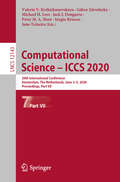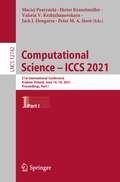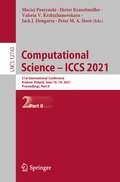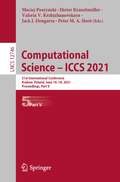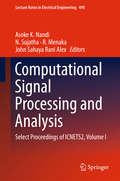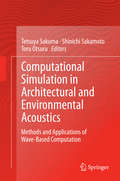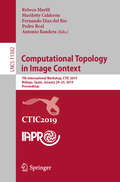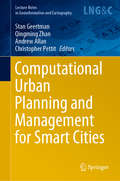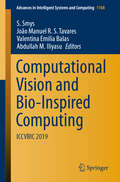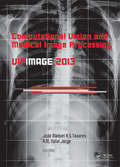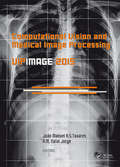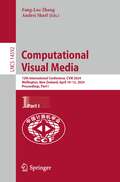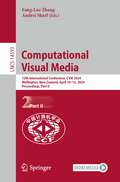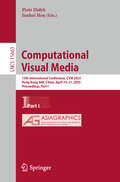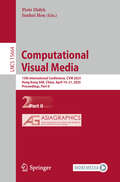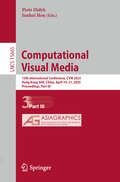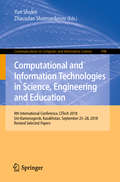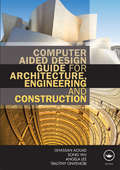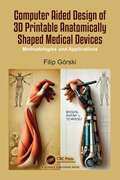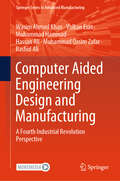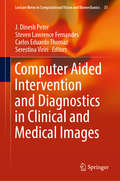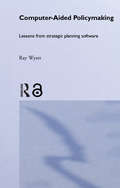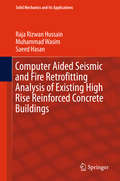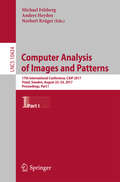- Table View
- List View
Computational Science – ICCS 2020: 20th International Conference, Amsterdam, The Netherlands, June 3–5, 2020, Proceedings, Part VI (Lecture Notes in Computer Science #12142)
by Valeria V. Krzhizhanovskaya Michael H. Lees Jack J. Dongarra Peter M. A. Sloot Gábor Závodszky Sérgio Brissos João TeixeiraThe seven-volume set LNCS 12137, 12138, 12139, 12140, 12141, 12142, and 12143 constitutes the proceedings of the 20th International Conference on Computational Science, ICCS 2020, held in Amsterdam, The Netherlands, in June 2020.* The total of 101 papers and 248 workshop papers presented in this book set were carefully reviewed and selected from 719 submissions (230 submissions to the main track and 489 submissions to the workshops). The papers were organized in topical sections named:Part I: ICCS Main Track Part II: ICCS Main Track Part III: Advances in High-Performance Computational Earth Sciences: Applications and Frameworks; Agent-Based Simulations, Adaptive Algorithms and Solvers; Applications of Computational Methods in Artificial Intelligence and Machine Learning; Biomedical and Bioinformatics Challenges for Computer SciencePart IV: Classifier Learning from Difficult Data; Complex Social Systems through the Lens of Computational Science; Computational Health; Computational Methods for Emerging Problems in (Dis-)Information AnalysisPart V: Computational Optimization, Modelling and Simulation; Computational Science in IoT and Smart Systems; Computer Graphics, Image Processing and Artificial IntelligencePart VI: Data Driven Computational Sciences; Machine Learning and Data Assimilation for Dynamical Systems; Meshfree Methods in Computational Sciences; Multiscale Modelling and Simulation; Quantum Computing Workshop Part VII: Simulations of Flow and Transport: Modeling, Algorithms and Computation; Smart Systems: Bringing Together Computer Vision, Sensor Networks and Machine Learning; Software Engineering for Computational Science; Solving Problems with Uncertainties; Teaching Computational Science; UNcErtainty QUantIficatiOn for ComputationAl modeLs*The conference was canceled due to the COVID-19 pandemic.
Computational Science – ICCS 2020: 20th International Conference, Amsterdam, The Netherlands, June 3–5, 2020, Proceedings, Part VII (Lecture Notes in Computer Science #12143)
by Valeria V. Krzhizhanovskaya Michael H. Lees Jack J. Dongarra Peter M. A. Sloot Gábor Závodszky Sérgio Brissos João TeixeiraThe seven-volume set LNCS 12137, 12138, 12139, 12140, 12141, 12142, and 12143 constitutes the proceedings of the 20th International Conference on Computational Science, ICCS 2020, held in Amsterdam, The Netherlands, in June 2020.*The total of 101 papers and 248 workshop papers presented in this book set were carefully reviewed and selected from 719 submissions (230 submissions to the main track and 489 submissions to the workshops). The papers were organized in topical sections named:Part I: ICCS Main TrackPart II: ICCS Main TrackPart III: Advances in High-Performance Computational Earth Sciences: Applications and Frameworks; Agent-Based Simulations, Adaptive Algorithms and Solvers; Applications of Computational Methods in Artificial Intelligence and Machine Learning; Biomedical and Bioinformatics Challenges for Computer SciencePart IV: Classifier Learning from Difficult Data; Complex Social Systems through the Lens of Computational Science; Computational Health; Computational Methods for Emerging Problems in (Dis-)Information AnalysisPart V: Computational Optimization, Modelling and Simulation; Computational Science in IoT and Smart Systems; Computer Graphics, Image Processing and Artificial IntelligencePart VI: Data Driven Computational Sciences; Machine Learning and Data Assimilation for Dynamical Systems; Meshfree Methods in Computational Sciences; Multiscale Modelling and Simulation; Quantum Computing Workshop Part VII: Simulations of Flow and Transport: Modeling, Algorithms and Computation; Smart Systems: Bringing Together Computer Vision, Sensor Networks and Machine Learning; Software Engineering for Computational Science; Solving Problems with Uncertainties; Teaching Computational Science; UNcErtainty QUantIficatiOn for ComputationAl modeLs*The conference was canceled due to the COVID-19 pandemic.Chapter ‘APE: A Command-Line Tool and API for Automated Workflow Composition’ is available open access under a Creative Commons Attribution 4.0 International License via link.springer.com.
Computational Science – ICCS 2021: 21st International Conference, Krakow, Poland, June 16–18, 2021, Proceedings, Part I (Lecture Notes in Computer Science #12742)
by Valeria V. Krzhizhanovskaya Dieter Kranzlmüller Jack J. Dongarra Peter M. A. Sloot Maciej PaszynskiThe six-volume set LNCS 12742, 12743, 12744, 12745, 12746, and 12747 constitutes the proceedings of the 21st International Conference on Computational Science, ICCS 2021, held in Krakow, Poland, in June 2021.*The total of 260 full papers and 57 short papers presented in this book set were carefully reviewed and selected from 635 submissions. 48 full and 14 short papers were accepted to the main track from 156 submissions; 212 full and 43 short papers were accepted to the workshops/ thematic tracks from 479 submissions. The papers were organized in topical sections named:Part I: ICCS Main Track Part II: Advances in High-Performance Computational Earth Sciences: Applications and Frameworks; Applications of Computational Methods in Artificial Intelligence and Machine Learning; Artificial Intelligence and High-Performance Computing for Advanced Simulations; Biomedical and Bioinformatics Challenges for Computer Science Part III: Classifier Learning from Difficult Data; Computational Analysis of Complex Social Systems; Computational Collective Intelligence; Computational Health Part IV: Computational Methods for Emerging Problems in (dis-)Information Analysis; Computational Methods in Smart Agriculture; Computational Optimization, Modelling and Simulation; Computational Science in IoT and Smart Systems Part V: Computer Graphics, Image Processing and Artificial Intelligence; Data-Driven Computational Sciences; Machine Learning and Data Assimilation for Dynamical Systems; MeshFree Methods and Radial Basis Functions in Computational Sciences; Multiscale Modelling and Simulation Part VI: Quantum Computing Workshop; Simulations of Flow and Transport: Modeling, Algorithms and Computation; Smart Systems: Bringing Together Computer Vision, Sensor Networks and Machine Learning; Software Engineering for Computational Science; Solving Problems with Uncertainty; Teaching Computational Science; Uncertainty Quantification for Computational Models *The conference was held virtually.Chapter “Deep Learning Driven Self-adaptive hp Finite Element Method” is available open access under a Creative Commons Attribution 4.0 International License via link.springer.com.
Computational Science – ICCS 2021: 21st International Conference, Krakow, Poland, June 16–18, 2021, Proceedings, Part II (Lecture Notes in Computer Science #12743)
by Valeria V. Krzhizhanovskaya Dieter Kranzlmüller Jack J. Dongarra Peter M. A. Sloot Maciej PaszynskiThe six-volume set LNCS 12742, 12743, 12744, 12745, 12746, and 12747 constitutes the proceedings of the 21st International Conference on Computational Science, ICCS 2021, held in Krakow, Poland, in June 2021.*The total of 260 full papers and 57 short papers presented in this book set were carefully reviewed and selected from 635 submissions. 48 full and 14 short papers were accepted to the main track from 156 submissions; 212 full and 43 short papers were accepted to the workshops/ thematic tracks from 479 submissions. The papers were organized in topical sections named:Part I: ICCS Main Track Part II: Advances in High-Performance Computational Earth Sciences: Applications and Frameworks; Applications of Computational Methods in Artificial Intelligence and Machine Learning; Artificial Intelligence and High-Performance Computing for Advanced Simulations; Biomedical and Bioinformatics Challenges for Computer Science Part III: Classifier Learning from Difficult Data; Computational Analysis of Complex Social Systems; Computational Collective Intelligence; Computational Health Part IV: Computational Methods for Emerging Problems in (dis-)Information Analysis; Computational Methods in Smart Agriculture; Computational Optimization, Modelling and Simulation; Computational Science in IoT and Smart Systems Part V: Computer Graphics, Image Processing and Artificial Intelligence; Data-Driven Computational Sciences; Machine Learning and Data Assimilation for Dynamical Systems; MeshFree Methods and Radial Basis Functions in Computational Sciences; Multiscale Modelling and Simulation Part VI: Quantum Computing Workshop; Simulations of Flow and Transport: Modeling, Algorithms and Computation; Smart Systems: Bringing Together Computer Vision, Sensor Networks and Machine Learning; Software Engineering for Computational Science; Solving Problems with Uncertainty; Teaching Computational Science; Uncertainty Quantification for Computational Models *The conference was held virtually.Chapter “Effective Solution of Ill-posed Inverse Problems with Stabilized Forward Solver” is available open access under a Creative Commons Attribution 4.0 International License via link.springer.com.
Computational Science – ICCS 2021: 21st International Conference, Krakow, Poland, June 16–18, 2021, Proceedings, Part V (Lecture Notes in Computer Science #12746)
by Valeria V. Krzhizhanovskaya Dieter Kranzlmüller Jack J. Dongarra Peter M. A. Sloot Maciej PaszynskiThe six-volume set LNCS 12742, 12743, 12744, 12745, 12746, and 12747 constitutes the proceedings of the 21st International Conference on Computational Science, ICCS 2021, held in Krakow, Poland, in June 2021.*The total of 260 full papers and 57 short papers presented in this book set were carefully reviewed and selected from 635 submissions. 48 full and 14 short papers were accepted to the main track from 156 submissions; 212 full and 43 short papers were accepted to the workshops/ thematic tracks from 479 submissions. The papers were organized in topical sections named:Part I: ICCS Main Track Part II: Advances in High-Performance Computational Earth Sciences: Applications and Frameworks; Applications of Computational Methods in Artificial Intelligence and Machine Learning; Artificial Intelligence and High-Performance Computing for Advanced Simulations; Biomedical and Bioinformatics Challenges for Computer Science Part III: Classifier Learning from Difficult Data; Computational Analysis of Complex Social Systems; Computational Collective Intelligence; Computational Health Part IV: Computational Methods for Emerging Problems in (dis-)Information Analysis; Computational Methods in Smart Agriculture; Computational Optimization, Modelling and Simulation; Computational Science in IoT and Smart Systems Part V: Computer Graphics, Image Processing and Artificial Intelligence; Data-Driven Computational Sciences; Machine Learning and Data Assimilation for Dynamical Systems; MeshFree Methods and Radial Basis Functions in Computational Sciences; Multiscale Modelling and Simulation Part VI: Quantum Computing Workshop; Simulations of Flow and Transport: Modeling, Algorithms and Computation; Smart Systems: Bringing Together Computer Vision, Sensor Networks and Machine Learning; Software Engineering for Computational Science; Solving Problems with Uncertainty; Teaching Computational Science; Uncertainty Quantification for Computational Models *The conference was held virtually.
Computational Signal Processing and Analysis: Select Proceedings Of Icnets2, Volume I (Lecture Notes In Electrical Engineering #490)
by Asoke K. Nandi N. Sujatha R. Menaka John Sahaya Rani AlexThis book comprises a collection of papers by international experts, presented at the International Conference on NextGen Electronic Technologies (ICNETS2-2017). ICNETS2 encompassed six symposia covering all aspects of electronics and communications engineering domains, including relevant nano/micro materials and devices. Featuring the latest research on computational signal processing and analysis, the book is useful to researchers, professionals, and students working in the core areas of electronics and their applications, especially signal processing, embedded systems, and networking.
Computational Simulation in Architectural and Environmental Acoustics: Methods and Applications of Wave-Based Computation
by Tetsuya Sakuma Shinichi Sakamoto Toru OtsuruThis book reviews a variety of methods for wave-based acoustic simulation and recent applications to architectural and environmental acoustic problems. Following an introduction providing an overview of computational simulation of sound environment, the book is in two parts: four chapters on methods and four chapters on applications. The first part explains the fundamentals and advanced techniques for three popular methods, namely, the finite-difference time-domain method, the finite element method, and the boundary element method, as well as alternative time-domain methods. The second part demonstrates various applications to room acoustics simulation, noise propagation simulation, acoustic property simulation for building components, and auralization. This book is a valuable reference that covers the state of the art in computational simulation for architectural and environmental acoustics.
Computational Topology in Image Context: 7th International Workshop, CTIC 2019, Málaga, Spain, January 24-25, 2019, Proceedings (Lecture Notes in Computer Science #11382)
by Rebeca Marfil Mariletty Calderón Fernando Díaz del Río Pedro Real Antonio BanderaThis book constitutes the proceedings of the 7th International Workshop on Computational Topology in Image Context, CTIC 2019, held in Málaga, Spain, in January 2019. The 14 papers presented in this volume were carefully reviewed and selected from 21 submissions. Papers deal with theoretical issues but most of them put the attention on the applicability of concepts and algorithms. These were designed to deal with objects and images, but also with the speech signal. The final application must be for instance in the medical domain or in the robotics one.
Computational Urban Planning and Management for Smart Cities (Lecture Notes in Geoinformation and Cartography)
by Stan Geertman Andrew Allan Qingming Zhan Christopher PettitThis book contains a selection of the best articles presented at the CUPUM (Computational Urban Planning and Urban Management) conference, held in the second week of July 2019 at the University of Wuhan, China. The chapters included were selected based on a double-blind review process involving external reviewers.
Computational Vision and Bio-Inspired Computing: ICCVBIC 2019 (Advances in Intelligent Systems and Computing #1108)
by João Manuel R. S. Tavares Valentina Emilia Balas S. Smys Abdullah M. IliyasuThis proceedings book presents state-of-the-art research innovations in computational vision and bio-inspired techniques. Due to the rapid advances in the emerging information, communication and computing technologies, the Internet of Things, cloud and edge computing, and artificial intelligence play a significant role in the computational vision context. In recent years, computational vision has contributed to enhancing the methods of controlling the operations in biological systems, like ant colony optimization, neural networks, and immune systems. Moreover, the ability of computational vision to process a large number of data streams by implementing new computing paradigms has been demonstrated in numerous studies incorporating computational techniques in the emerging bio-inspired models. The book reveals the theoretical and practical aspects of bio-inspired computing techniques, like machine learning, sensor-based models, evolutionary optimization, and big data modeling and management, that make use of effectual computing processes in the bio-inspired systems. As such it contributes to the novel research that focuses on developing bio-inspired computing solutions for various domains, such as human–computer interaction, image processing, sensor-based single processing, recommender systems, and facial recognition, which play an indispensable part in smart agriculture, smart city, biomedical and business intelligence applications.
Computational Vision and Medical Image Processing IV: VIPIMAGE 2013
by João Manuel R.S. Tavares R.M. Natal JorgeComputational Vision and Medical Image Processing. VIPIMAGE 2013 contains invited lectures and full papers presented at VIPIMAGE 2013 - IV ECCOMAS Thematic Conference on Computational Vision and Medical Image Processing (Funchal, Madeira Island, Portugal, 14-16 October 2013). International contributions from 16 countries provide a comprehensive cov
Computational Vision and Medical Image Processing V: Proceedings of the 5th Eccomas Thematic Conference on Computational Vision and Medical Image Processing (VipIMAGE 2015, Tenerife, Spain, October 19-21, 2015)
by João Manuel R.S. Tavares R.M. Natal JorgeVipIMAGE 2015 contains invited lectures and full papers presented at VIPIMAGE 2015 - V ECCOMAS Thematic Conference on Computational Vision and Medical Image Processing (Tenerife, Canary Islands, Spain, 19-21 October, 2015). International contributions from 19 countries provide a comprehensive coverage of the current state-of-the-art in the fields o
Computational Visual Media: 12th International Conference, CVM 2024, Wellington, New Zealand, April 10–12, 2024, Proceedings, Part I (Lecture Notes in Computer Science #14592)
by Andrei Sharf Fang-Lue ZhangThis book constitutes the refereed proceedings of CVM 2024, the 12th International Conference on Computational Visual Media, held in Wellington, New Zealand, in April 2024.The 34 full papers were carefully reviewed and selected from 212 submissions. The papers are organized in topical sections as follows:Part I: Reconstruction and Modelling, Point Cloud, Rendering and Animation, User Interations.Part II: Facial Images, Image Generation and Enhancement, Image Understanding, Stylization, Vision Meets Graphics.
Computational Visual Media: 12th International Conference, CVM 2024, Wellington, New Zealand, April 10–12, 2024, Proceedings, Part II (Lecture Notes in Computer Science #14593)
by Andrei Sharf Fang-Lue ZhangThis book constitutes the refereed proceedings of CVM 2024, the 12th International Conference on Computational Visual Media, held in Wellington, New Zealand, in April 2024.The 34 full papers were carefully reviewed and selected from 212 submissions. The papers are organized in topical sections as follows:Part I: Reconstruction and Modelling, Point Cloud, Rendering and Animation, User Interations.Part II: Facial Images, Image Generation and Enhancement, Image Understanding, Stylization, Vision Meets Graphics.
Computational Visual Media: 13th International Conference, CVM 2025, Hong Kong SAR, China, April 19–21, 2025, Proceedings, Part I (Lecture Notes in Computer Science #15663)
by Piotr Didyk Junhui HouThis book constitutes the refereed proceedings of CVM 2025, the 13th International Conference on Computational Visual Media, held in Hong Kong SAR, China, in April 2025. The 67 full papers were carefully reviewed and selected from 335 submissions. The papers are organized in topical sections as follows: Part I: Medical Image Analysis, Detection and Recognition, Image Enhancement and Generation, Vision Modeling in Complex Scenarios Part II: 3D Geometry and Rendering, Generation and Editing, Image Processing and Optimization Part III: Image and Video Analysis, Multimodal Learning, Geometrical Processing, Applications
Computational Visual Media: 13th International Conference, CVM 2025, Hong Kong SAR, China, April 19–21, 2025, Proceedings, Part II (Lecture Notes in Computer Science #15664)
by Piotr Didyk Junhui HouThis book constitutes the refereed proceedings of CVM 2025, the 13th International Conference on Computational Visual Media, held in Hong Kong SAR, China, in April 2025. The 67 full papers were carefully reviewed and selected from 335 submissions. The papers are organized in topical sections as follows: Part I: Medical Image Analysis, Detection and Recognition, Image Enhancement and Generation, Vision Modeling in Complex Scenarios Part II: 3D Geometry and Rendering, Generation and Editing, Image Processing and Optimization Part III: Image and Video Analysis, Multimodal Learning, Geometrical Processing, Applications
Computational Visual Media: 13th International Conference, CVM 2025, Hong Kong SAR, China, April 19–21, 2025, Proceedings, Part III (Lecture Notes in Computer Science #15665)
by Piotr Didyk Junhui HouThis book constitutes the refereed proceedings of CVM 2025, the 13th International Conference on Computational Visual Media, held in Hong Kong SAR, China, in April 2025. The 67 full papers were carefully reviewed and selected from 335 submissions. The papers are organized in topical sections as follows: Part I: Medical Image Analysis, Detection and Recognition, Image Enhancement and Generation, Vision Modeling in Complex Scenarios Part II: 3D Geometry and Rendering, Generation and Editing, Image Processing and Optimization Part III: Image and Video Analysis, Multimodal Learning, Geometrical Processing, Applications
Computational and Information Technologies in Science, Engineering and Education: 9th International Conference, CITech 2018, Ust-Kamenogorsk, Kazakhstan, September 25-28, 2018, Revised Selected Papers (Communications in Computer and Information Science #998)
by Yuri Shokin Zhassulan ShaimardanovThis book constitutes the refereed proceedings of the 9th International Conference on Computational and Information Technologies in Science, Engineering and Education, CITech 2018, held in Ust-Kamenogorsk, Kazakhstan, in September 2018.The 25 revised full papers presented were carefully reviewed and selected from 64 submissions. The papers address issues such as mathematical and computer modeling, fundamental problems of mathematics, technological aspects of the applications of parallel computer systems, high level parallel programming languages and systems.
Computer Aided Design Guide for Architecture, Engineering and Construction
by Ghassan Aouad Song Wu Angela Lee Timothy OnyenobiRecent years have seen major changes in the approach to Computer Aided Design (CAD) in the architectural, engineering and construction (AEC) sector. CAD is increasingly becoming a standard design tool, facilitating lower development costs and a reduced design cycle. Not only does it allow a designer to model designs in two and three dimensions but also to model other dimensions, such as time and cost into designs. Computer Aided Design Guide for Architecture, Engineering and Construction provides an in-depth explanation of all the common CAD terms and tools used in the AEC sector. It describes each approach to CAD with detailed analysis and practical examples. Analysis is provided of the strength and weaknesses of each application for all members of the project team, followed by review questions and further tasks. Coverage includes: 2D CAD 3D CAD 4D CAD nD modelling Building Information Modelling parametric design, virtual reality and other areas of future expansion. With practical examples and step-by step guides, this book is essential reading for students of design and construction, from undergraduate level onwards.
Computer Aided Design of 3D Printable Anatomically Shaped Medical Devices: Methodologies and Applications
by Filip Gorski"Computer Aided Design of 3D Printable Anatomically Shaped Medical Devices: Methodologies and Applications" presents a comprehensive framework for designing 3D printable medical devices tailored to individual anatomies. Bridging engineering and medicine, the book guides readers through advanced CAD techniques, anatomical data acquisition (via 3D scanning and imaging), and additive manufacturing processes, presenting mostly results of author's own and co-authored research. Emphasizing efficiency, customization, and real-world applications, it showcases methodologies developed in collaboration with medical professionals for orthopedic devices, surgical aids, and prosthetics. Case studies offer insights into practical uses, demonstrating how these innovations enhance patient care and surgical outcomes through personalized, accessible solutions.
Computer Aided Engineering Design and Manufacturing: A Fourth Industrial Revolution Perspective (Springer Series in Advanced Manufacturing)
by Wasim Ahmed Khan Rashid Ali Volkan Esat Muhammad Hammad Hassan Ali Muhammad Qasim ZafarThis text introduces the modern concepts relevant to system engineering design and manufacturing from a 4th Industrial Revolution perspective. The book surveys the current status and cutting edge in Computer Aided Design and Computer Aided Manufacturing (CAD/CAM). This bridges the gaps between academic research and industry. It consists of seven parts and seventeen chapters that first structure the subject areas and later detail the main topics under consideration. Each part of the book and each chapter contains a prelude guiding the reader in a systematic way to the next part or topic. The book explains concepts using state-of-the-art teaching methods, using objectives, learning outcomes and review questions. MS PowerPoint Slides and Solution Manual for instructors are available online as well as videos.
Computer Aided Intervention and Diagnostics in Clinical and Medical Images (Lecture Notes in Computational Vision and Biomechanics #31)
by J. Dinesh Peter Steven Lawrence Fernandes Carlos Eduardo Thomaz Serestina ViririThis book is a compendium of the ICCMIA 2018 proceedings, which provides an ideal reference for all medical imaging researchers and professionals to explore innovative methods and analyses on imaging technologies for better prospective patient care.This work serves as an exclusive source for new computer assisted clinical and medical developments in imaging diagnosis, intervention and analysis. It includes articles on computer assisted medical scanning techniques, computer-aided diagnosis, robotic surgery and imaging, imaging genomics, clinically-oriented imaging physics and informatics, augmented-reality medical visualization, imaging modalities, computerized radiology, oncology, and surgery. Moreover, information on non-medical imaging that has medical applications such as multi-photon microscopy and confocal, photoacoustic imaging, optical microendoscope, infra-red radiation, and other imaging modalities is also represented.
Computer Aided Policy Making
by Ray WyattThis book will prove a unique source of information and instruction for anyone seeking to make better human-oriented policy, whether urban planner, business strategist, or manager in the field of education, health or welfare,Ingeniously Wyatt has created two books in one: the main text covers the types of software package available: mainstream software, peripheral software, innovative software, frontier software; the lessons generated from the software are outlined in lesson boxes. Readers can use the text alone to familiarize themselves with the computer packages or read the boxes only, or they can do both.
Computer Aided Seismic and Fire Retrofitting Analysis of Existing High Rise Reinforced Concrete Buildings (Solid Mechanics and Its Applications #222)
by Raja Rizwan Hussain Muhammad Wasim Saeed HasanThis book details the analysis and design of high rise buildings for gravity and seismic analysis. It provides the knowledge structural engineers need to retrofit existing structures in order to meet safety requirements and better prevent potential damage from such disasters as earthquakes and fires. Coverage includes actual case studies of existing buildings, reviews of current knowledge for damages and their mitigation, protective design technologies, and analytical and computational techniques. This monograph also provides an experimental investigation on the properties of fiber reinforced concrete that consists of natural fibres like coconut coir and also steel fibres that are used for comparison in both Normal Strength Concrete (NSC) and High Strength Concrete (HSC). In addition, the authors examine the use of various repair techniques for damaged high rise buildings. The book will help upcoming structural design engineers learn the computer aided analysis and design of real existing high rise buildings by using ACI code for application of the gravity loads, UBC- 97 for seismic analysis and retrofitting analysis by computer models. It will be of immense use to the student community, academicians, consultants and practicing professional engineers and scientists involved in the planning, design, execution, inspection and supervision for the proper retrofitting of buildings.
Computer Analysis of Images and Patterns: 17th International Conference, CAIP 2017, Ystad, Sweden, August 22-24, 2017, Proceedings, Part I (Lecture Notes in Computer Science #10424)
by Michael Felsberg Anders Heyden Norbert KrügerThe two volume set LNCS 10424 and 10425 constitutes the refereed proceedings of the 17th International Conference on Computer Analysis of Images and Patterns, CAIP 2017, held in Ystad, Sweden, in August 2017. The 72 papers presented were carefully reviewed and selected from 144 submissions The papers are organized in the following topical sections: Vision for Robotics; Motion and Tracking; Segmentation; Image/Video Indexing and Retrieval; Shape Representation and Analysis; Biomedical Image Analysis; Biometrics; Machine Learning; Image Restoration; and Poster Sessions.

